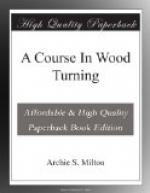After the first coat has hardened apply the second, but use less shellac and more alcohol and just enough oil to prevent the pad from sticking. This may be done by dipping the tip of a finger in the oil and spreading it over the pad. The entire mixture should be so that only a dampness can be felt on the pad. As the process goes on less oil and shellac are used. All oil must be removed when applying the last coat, or the piece will lose its polish. All the pores should be filled, and no rings should be on the finished work. Where a natural finish is desired, apply a coat of boiled linseed oil twelve hours before the work is to be polished. This will bring out the grain and will also aid in applying the first coat; no oil need then be used in the first coat.
A great amount of practice and patience is required to get a first class polish. Polishing can only be learned by experience. Correct your troubles in properly proportioning the mixture. Never use too much shellac as it will build up too fast and will not harden, thus causing rings; or it will pull and catch to the pad, thus forming bunches. The purpose of alcohol is mainly to dilute the shellac and to prevent against putting it on the work too fast, but care must be taken not to use too much alcohol to cut the shellac entirely. The oil helps to distribute the shellac evenly, but it must be removed when finishing the last coat, or the polish will not remain. It also helps to keep the pad from sticking to the work.
It is impossible to obtain a polish that will be as lasting and rich by any method other than the one described. For success it is essential to learn the proportions of the mixture and to acquire skill in applying the materials by using exactly the right pressure and the right movement of the pad.
CHAPTER IX
FACE-PLATE AND CHUCK TURNING
Face-plate and chuck turning open an entirely new field of work from that taken up in previous chapters of this book. If handled correctly, it has much greater educational and practical value than cylinder turning. From the practical standpoint the field of work is broader and the models to be made are of much greater value. Aside from this, trade methods and practices can be applied and a broad insight into commercial work can be given the student.




